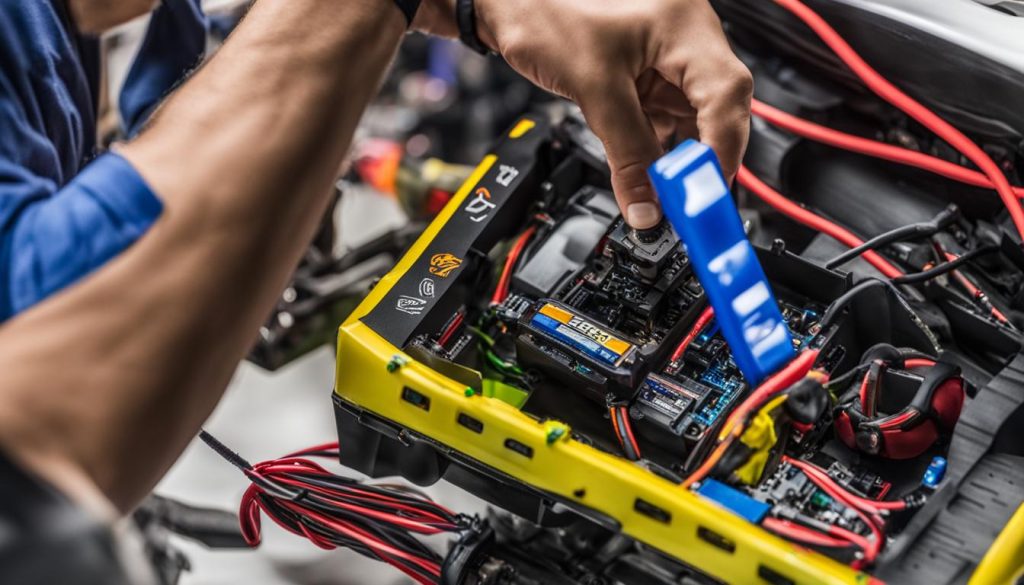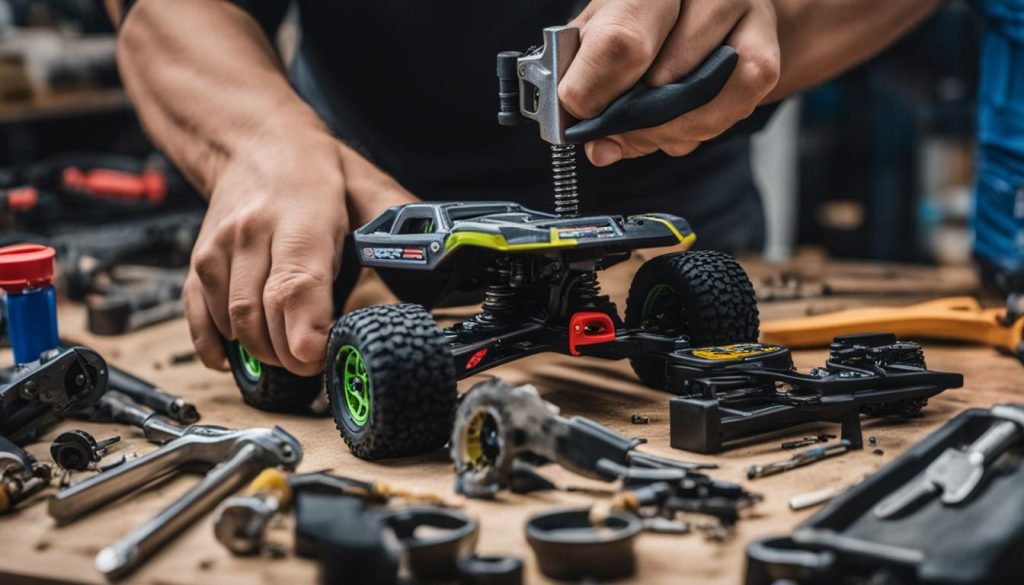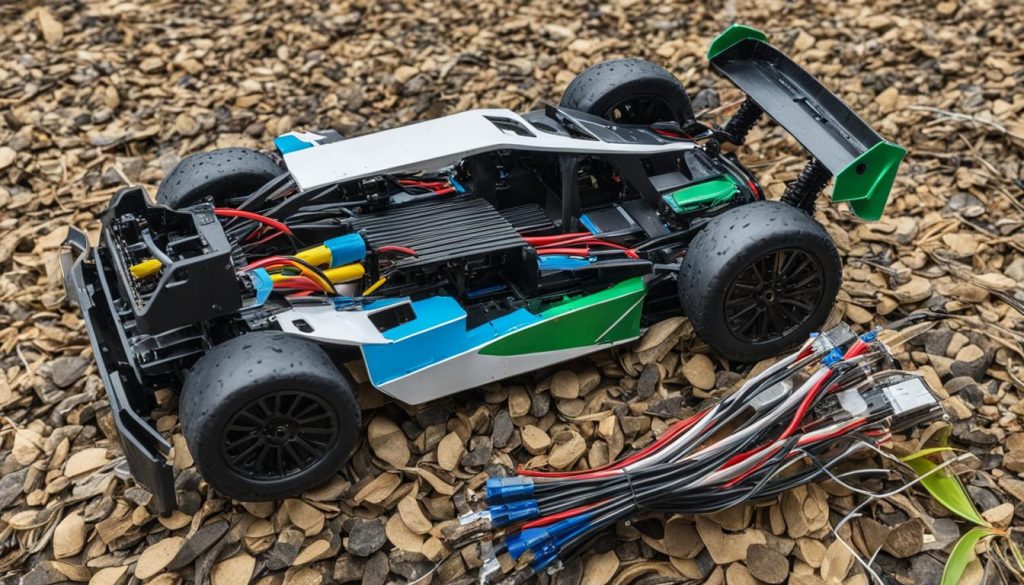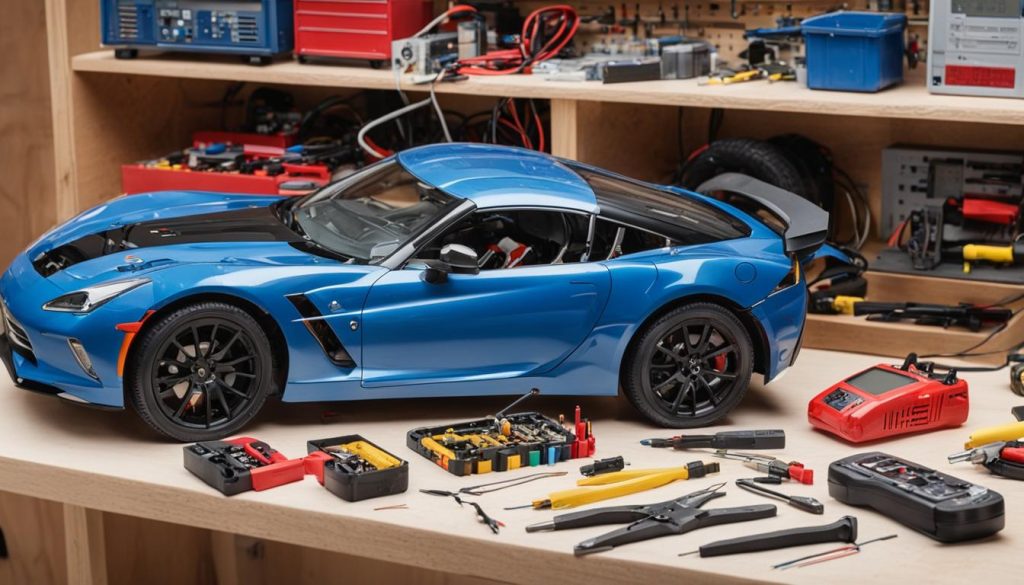When it comes to remotely controlling your RC car, you might be wondering if it’s possible to change the controller. The good news is, yes, you can change the controller of an RC car. Whether you’re looking to replace a faulty controller, upgrade to a more advanced model, or simply swap out your current controller for a different one, there are options available to suit your needs.
Changing the controller of an RC car can offer a range of benefits. It allows you to customize and enhance the performance and handling of your RC car, making it more enjoyable to drive. Additionally, replacing the controller can give you access to new features and functionalities that may not be available with your current setup.
Upgrading an RC car controller can involve selecting a compatible replacement transmitter that suits your specific RC car model. It’s important to consider factors such as compatibility, functionality, and ease of use when choosing a new controller. There are various types of transmitters available, including pistol grip transmitters and stick transmitters, each with its own advantages and features.
Before making any changes, it’s essential to ensure the compatibility of the new controller with your RC car. Understanding the transmitter channels and their allocation, as well as the communication technology used (such as 2.4Ghz), can help ensure a seamless transition and optimal performance.
If you’re unsure about how to change the controller of an RC car or have any concerns, it’s a good idea to consult the user manual or seek advice from RC car enthusiasts or experts. They can provide guidance on the specific steps and considerations for your particular RC car model and controller.
Upgrading or swapping the controller of an RC car is an exciting prospect that opens up new possibilities for customization and enhanced performance. With the right knowledge and resources, you can take your RC car experience to the next level.
Key Takeaways:
- Yes, you can change the controller of an RC car.
- Replacing the controller can offer benefits such as customization and enhanced performance.
- Consider compatibility, functionality, and ease of use when choosing a new controller.
- Ensure compatibility with your RC car and understand transmitter channels and communication technology (such as 2.4Ghz).
- Consult user manuals or seek advice from experts for specific guidance on changing the controller.
Types of Transmitters
When it comes to controlling your RC car, choosing the right transmitter is crucial. There are two main types of transmitters to consider: the pistol grip transmitter and the stick transmitter.
The pistol grip transmitter is designed with a “hand-gun” style layout, featuring a trigger for throttle control and a wheel mounted on the side for steering. This compact and ergonomic design offers a comfortable grip and intuitive control. The pistol grip transmitter is self-centering, meaning the wheel returns to the center position automatically when released. This feature allows for precise steering control and makes it a popular choice among RC car enthusiasts.
On the other hand, the stick transmitter utilizes two input sticks to control throttle and steering. With the stick transmitter, you have a two-dimensional input for controlling the speed and direction of your RC car. This type of transmitter offers a high level of configurability and adjustability, allowing you to fine-tune your control settings. Stick transmitters are favored by experienced RC car drivers who prefer a more customizable control interface.
The choice between a pistol grip transmitter and a stick transmitter ultimately depends on personal preference and comfort. Some RC car enthusiasts prefer the simplicity and natural feel of the pistol grip transmitter, while others enjoy the flexibility and customization options of the stick transmitter. Consider your own driving style and experience level when selecting the right transmitter for your RC car.
Differences between Pistol Grip and Stick Transmitters
| Pistol Grip Transmitter | Stick Transmitter |
|---|---|
| Ergonomic “hand-gun” style layout | Two input sticks for throttle and steering control |
| Trigger for throttle control | Two-dimensional input for throttle and steering control |
| Compact and self-centering | Highly configurable and adjustable |
| Popular choice for beginners | Favored by experienced drivers |
As you can see, there are distinct differences between the pistol grip and stick transmitters. Choose the transmitter that best suits your driving style and preferences to maximize your RC car control and enjoyment.
Transmitter Channels
Transmitters for RC cars are equipped with multiple channels that serve different functions in controlling the vehicle. Understanding the allocation and utilization of these channels is essential for seamless operation of your RC car.
Typically, the steering servo is connected to channel one, allowing precise control over the direction of the RC car. On the other hand, channel two is reserved for throttle control, connecting to the speed controller to regulate the car’s speed. These two primary channels are the foundation of basic RC car control.
However, some transmitters offer additional channels beyond one and two. These extra channels can be used to remotely operate secondary features of the RC car, such as lights or a winch. The availability of these channels may vary depending on the model and brand of the RC car you own.
It’s important to consult the user manual or documentation provided by the manufacturer to understand the specific channel allocation for your RC car. By leveraging the various channels, you can expand the functionality of your RC car and customize its operation to suit your preferences and needs.
Channels Allocation for Common RC Car Functions
| Channel | Function |
|---|---|
| 1 | Steering servo control |
| 2 | Throttle control |
| 3 | Lights control (optional) |
| 4 | Winch control (optional) |
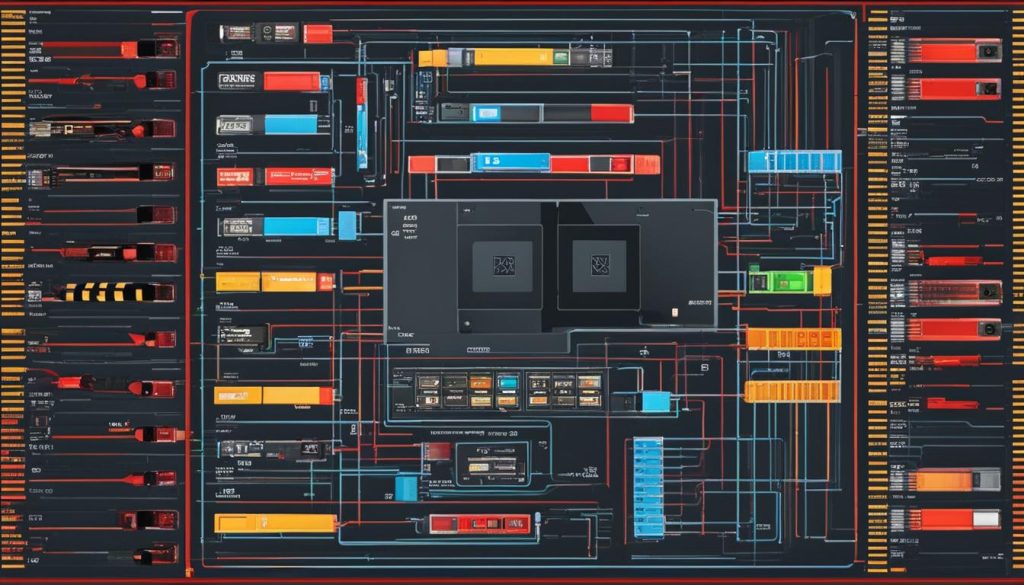
Understanding the functionality and allocation of transmitter channels is crucial for mastering the control of your RC car. By utilizing additional channels, you can enjoy enhanced features and functionality, taking your RC car experience to the next level.
Transmitting over 2.4Ghz
Modern RC car radio systems utilize advanced 2.4Ghz frequency for wireless data transmission between the transmitter and the receiver. Unlike older systems that relied on narrow-band frequencies and often encountered interference issues, 2.4Ghz systems incorporate cutting-edge direct sequence or automatic frequency hopping technologies. These innovative techniques distribute the transmissions over a wider selection of frequencies or channels, resulting in a more robust and interference-resistant connection. This enhanced reliability offers impressive range and ensures uninterrupted control over your RC car.
The advantages of 2.4Ghz frequency in RC cars are significant. The digital radio systems used in 2.4Ghz systems allow for precise and accurate control, providing a seamless driving experience. Additionally, the use of this frequency eliminates the need for manual frequency management, as there is no overlap or interference with other RC car operators.
One of the key benefits of 2.4Ghz systems is their resistance to interference. With the wider range of frequencies available, the chances of encountering interference from other devices operating on similar frequencies are greatly reduced. This means that your RC car will not be affected by nearby Wi-Fi networks, wireless baby monitors, or other electronic devices that can disrupt the performance of older RC car systems. Interference resistance is crucial for maintaining a stable and uninterrupted connection between the transmitter and receiver, ensuring precise control over your RC car.
In addition to their interference resistance, 2.4Ghz radio systems offer improved range compared to older systems. The robust wireless data transmission capabilities of 2.4Ghz technology allow you to control your RC car from a greater distance without experiencing signal degradation. Whether you’re racing, bashing, or performing intricate maneuvers, the reliable range of a 2.4Ghz system ensures that you stay in control at all times.
| Advantages of 2.4Ghz Frequency in RC Cars |
|---|
| Interference resistance |
| Improved range |
| Accurate and precise control |
| Elimination of manual frequency management |
Binding a Transmitter
Most transmitters that come bundled with RC car models are pre-bound to their respective receivers. However, in case you need to replace components or bind a new transmitter to an existing receiver, it is important to follow the proper steps. The specific binding process may vary depending on the brand and model of the transmitter-receiver system. For example, the Syncro system by Kyosho requires holding down the bind button while powering up the model and then turning on the transmitter before releasing the bind button. Similarly, the TQi Top Qualifier radio by Traxxas requires pressing and holding the red set button on the transmitter while turning it on, and then pressing and holding the link button on the receiver while turning on the speed controller. It is essential to consult the manual or documentation provided by the manufacturer for detailed instructions on binding a transmitter.
Transmitter Adjustments
Transmitters for RC cars are equipped with various adjustment controls that allow you to fine-tune the settings and characteristics of the receiver’s control signals. These adjustments give you the ability to customize the steering and throttle inputs according to your preferences, resulting in optimal performance and handling of your RC car.
Below, we’ll explore some of the key transmitter adjustments that can greatly enhance your RC car’s performance:
Trim Adjustment
Trim adjustment is a crucial feature that allows you to fine-tune the inputs from the transmitter. By making small adjustments, you can ensure that your RC car tracks straight, even on uneven surfaces. Whether it’s compensating for slight misalignment or countering external factors like wind, trim adjustment ensures that your RC car maintains a steady course.
Dual Rate Adjustment
Dual rate adjustment provides you with control over the maximum input or output of your transmitter. By scaling down the response, you can achieve fine control over the steering and throttle inputs. This adjustment is particularly useful when you require precise maneuvering or when you’re navigating tight corners or obstacles.
Reverse Switches
Reverse switches allow you to reverse the signal sent from the transmitter to the receiver. This feature proves invaluable when you need to correct any directional issues. By reversing the control inputs, you can effectively counteract undesired turning tendencies and maintain complete control over your RC car.
End-Point Adjustment
End-point adjustment enables you to adjust the maximum travel of the servo for various actions, such as left, right, forward, and reverse. This adjustment ensures that your RC car’s servo doesn’t exceed its intended range of motion, preventing any potential strain or damage to the steering system. Fine-tuning the end-point adjustment allows you to optimize the turning radius and overall maneuverability of your RC car.
Exponential Adjustment
Exponential adjustment modifies the behavior of the transmitter inputs. It allows you to fine-tune the response curve, making it either smoother or more aggressive. This adjustment is particularly useful for tailoring the steering and throttle inputs to your specific driving style and preferences. Whether you prefer a gradual and predictable response or a more immediate and aggressive one, exponential adjustment lets you achieve precisely the control you desire.
| Transmitter Adjustment | Description |
|---|---|
| Trim Adjustment | Tunes the inputs from the transmitter for straight tracking |
| Dual Rate Adjustment | Scales down the response for fine control |
| Reverse Switches | Allows reversing the control inputs for correction |
| End-Point Adjustment | Adjusts the maximum travel of the servo for precise action |
| Exponential Adjustment | Modifies the response curve for personalized control |
By utilizing these transmitter adjustments, you can unlock the full potential of your RC car and achieve the ideal performance and handling characteristics for your driving style. Experimenting with different settings and finding the perfect balance will enhance your RC car experience and take your skills to new heights.
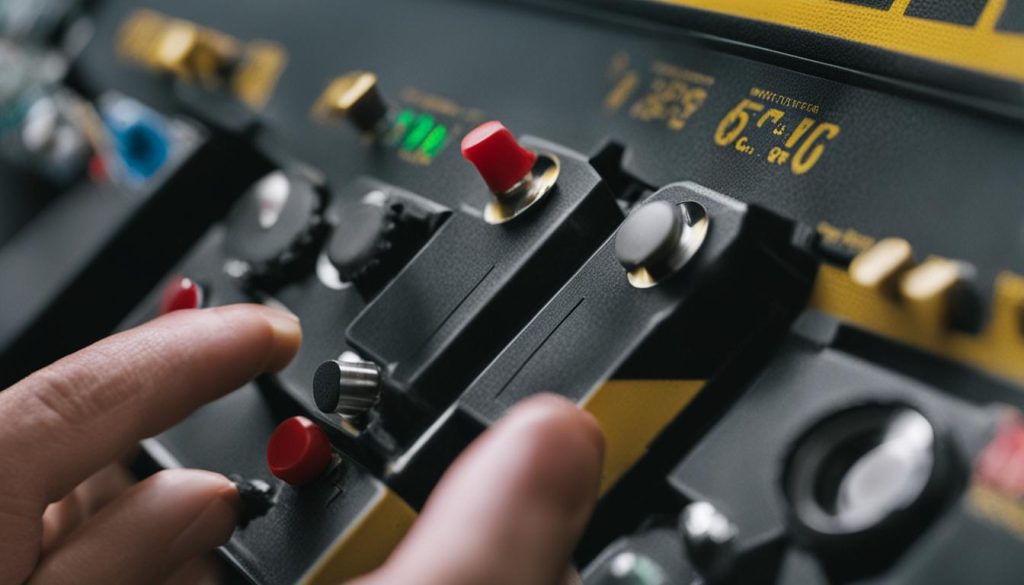
Troubleshooting RC Communication Issues
If your RC car is not responding to signals from the transmitter, there are several troubleshooting steps you can take to identify and resolve the issue.
- Check Power: First, ensure that both the RC car and the transmitter have fresh batteries and that they are turned on. Weak or depleted batteries can cause communication problems.
- Verify Frequency: Check if the frequency of the transmitter matches the receiver in the RC car. If the frequencies do not match, the RC car will not respond to the transmitter’s signals.
- Inspect Antennas: Make sure the antennas on both the transmitter and the RC car are properly installed, undamaged, and securely attached. A damaged or improperly installed antenna can weaken the signal and affect communication.
- Try Another Transmitter or RC: If possible, try using another transmitter or another RC car of the same frequency to isolate the problem. This will help determine if the issue lies with the transmitter or the RC car.
- Check Receiver and Servos: If the servos in the RC car are not responding to signals, it may indicate a problem with the receiver or the servos themselves. Inspect the receiver for any visible damage or loose connections. Consider replacing the receiver if necessary.
If all troubleshooting steps fail to resolve the communication issues, you may need to consider returning the RC car or seeking professional repairs. A professional technician will have the expertise to diagnose and fix complex problems that may be affecting the transmitter and receiver.
When to Seek Professional Repairs
If all troubleshooting steps fail to resolve the communication issues between the transmitter and the RC car, it may be necessary to seek professional repairs. Professional RC car repair technicians have the expertise and tools to diagnose and fix complex problems. However, it is important to consider the cost of repairs compared to the value of the RC car. Hobby-grade RCs, which are more expensive, may be worth repairing, especially if they have sentimental or significant value. On the other hand, toy-grade RCs, which are less expensive, may not be cost-effective to repair. It is important to weigh the pros and cons and make an informed decision when it comes to seeking professional repairs.
If you have tried extensive troubleshooting and repairs, and the communication issue between the transmitter and RC car persists, reaching out to an experienced RC car repair technician could be your best option. These professionals have in-depth knowledge of RC car systems and can perform diagnostics to identify the underlying problem. They have access to specialized tools and replacement parts to ensure accurate repairs. Seeking professional RC car repairs can save you time and frustration, allowing you to get your RC car back in action as quickly as possible.
“When it comes to fixing complex issues with RC cars, professional repair services are invaluable. Their expertise, experience, and access to tools and replacement parts make them the best choice for resolving communication problems between the transmitter and the RC car.” – RC Car Enthusiast
It’s important to consider the repair costs in relation to the value of your RC car. Hobby-grade RC cars, which are more expensive and are often highly customizable, may be worth the investment in professional repairs. These RC cars can hold sentiment or have unique features that make them worth preserving. Additionally, hobby-grade RC cars tend to have higher-quality components, making them more likely candidates for repair.
On the other hand, toy-grade RC cars, which are generally more affordable and often designed for younger enthusiasts, may not be as cost-effective to repair. The repair costs can outweigh the value and performance benefits of attempting repairs. In these cases, it may be more practical to consider purchasing a new RC car instead.
Comparing Repair Costs and RC Car Value
| RC Car Grade | Repair Costs | RC Car Value | Recommended Action |
|---|---|---|---|
| Hobby-grade | Depends on the specific repair | Expensive, rare, or highly customized | Consider professional repairs |
| Toy-grade | May exceed the value of the RC car | Affordable and readily available | Buying a new RC car may be more practical |
Conclusion
In conclusion, changing the controller of an RC car presents an opportunity for you to upgrade and personalize the performance and handling of your RC car. With various types of transmitters available, such as pistol grip and stick transmitters, you can choose the one that best suits your preferences and comfort. Understanding the transmitter channels, 2.4Ghz technology, and transmitter adjustments can enhance your overall experience in controlling your RC car.
While troubleshooting communication issues between the transmitter and the RC car can be challenging, following the proper steps and seeking professional repairs when necessary can help resolve the problems. Don’t hesitate to consult the manual or documentation provided by the manufacturer for detailed instructions on binding a transmitter or troubleshooting communication issues.
By upgrading and customizing the controller of your RC car, you can unlock new possibilities and elevate your enjoyment of this exciting hobby. So go ahead and explore the world of changing RC car controllers, upgrading them, and troubleshooting any issues that may arise. Happy racing!
FAQ
Can you change the controller of an RC car?
Yes, you can change the controller of an RC car. There are various options available for changing the controller, allowing you to upgrade and customize the performance and handling of your RC car.
What are the types of transmitters for RC cars?
The two main types of transmitters for RC cars are the pistol grip transmitter and the stick transmitter. The pistol grip transmitter features a trigger for throttle control and a wheel for steering, while the stick transmitter has two input sticks for throttle and steering control.
How are the transmitter channels allocated in RC cars?
Transmitters for RC cars traditionally have multiple channels for different functions. The steering servo is typically connected to channel one, while the speed controller is connected to channel two for throttle control. Some transmitters have additional channels that can be used for operating lights or a winch.
What is 2.4Ghz technology in RC cars?
Modern RC car radio systems use 2.4Ghz frequency for wireless data transmission between the transmitter and the receiver. This technology provides a more robust and interference-resistant connection, resulting in impressive range and reliability.
How do you bind a new transmitter to an RC car?
The specific binding process may vary depending on the brand and model of the transmitter-receiver system. It is important to consult the manual or documentation provided by the manufacturer for detailed instructions on binding a transmitter.
What adjustments can be made to the transmitter?
Transmitters for RC cars feature various adjustment controls to fine-tune the settings and characteristics of the receiver’s control signals. These adjustments include trim adjustment, dual rate adjustment, reverse switches, end-point adjustment, and exponential adjustment.
What should I do if my RC car is not responding to signals from the transmitter?
If your RC car is not responding to signals, there are several steps to troubleshoot the issue. First, ensure that both the RC and the transmitter have fresh batteries and are turned on. Check if the frequency of the transmitter matches the receiver in the RC. Additionally, make sure the antennas on both the transmitter and the RC are properly installed and not damaged. If the problem persists, seeking professional repairs may be necessary.
When should I seek professional repairs for my RC car?
If troubleshooting steps fail to resolve communication issues between the transmitter and the RC car, it may be necessary to seek professional repairs. Consider the cost of repairs compared to the value of the RC car to make an informed decision.
Can upgrading the controller of an RC car enhance its performance?
Yes, upgrading and customizing the controller of an RC car can open up new possibilities and greatly enhance its performance and handling, providing a more enjoyable experience.

